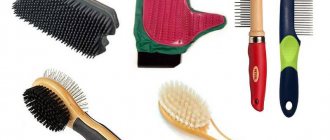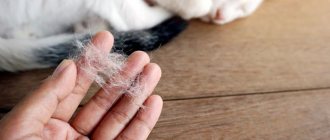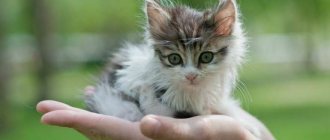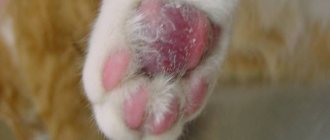What you need to know before getting a kitten
Deciding to get a kitten is a wonderful thing, but are you sure you're ready for it? Many people forget that behind the cute fluffiness in the picture lies a lot of responsibilities for caring for a pet, expenses for its maintenance and various factors that can cause some discomfort to you as the owner.
Thus, a cute animal will regularly demand food and water, and after eating it, it will go to the toilet. And this will be repeated regularly. Are you ready to clean your cat's litter box at least once a day? But there are also picky cats who will not go into an uncleaned litter box, but will go somewhere else. For your favorite T-shirt, for example. Kittens that are not litter box trained may also go to the toilet in inappropriate places. Are you ready to endure such behavior without unnecessary emotions and raise a cat? This will require from you, at a minimum, a desire to understand the issue and considerable patience, because cats are quite difficult to educate, and it is necessary to carry out educational activities during the cat’s childhood.
The cat will need your attention, toys and various little things to care for it. He will need to be vaccinated, neutered, or sexually active. All this will require your time, effort and money. Are you ready for this?
But there will also be cat hair, which will become an integral attribute of your clothes. There will be parasites that you will have to remove not only from your pet, but also from yourself and your children, if you have them. There will be persistent awakening in the morning because, for example, the bowl is empty. There will be various harms, which may be the result of improper upbringing, or may simply be manifestations of the cat’s temperament.
Are you sure you are ready for this and want to get a kitten? You should think about this in advance, because when you meet someone in the yard, or at a flea market, or at a kitten’s house, it will be too late to think about it. No one can resist his lordship. I'll have to take it.
Fluffy kitten sitting in front of a bowl
How to properly hold a cat in your arms
In this case, you need to follow several rules with both adult animals and kittens:
- You need to approach the animal without sudden movements so that it can see you. It is best to approach from the right or left, because a direct approach may be perceived as a threat.
- You need to “get to know” the animal, let it sniff your palm or legs, for example.
- Cats usually express their desire to get to know you better, or lack thereof, with unambiguous hints: either they rub against your legs and look ingratiatingly into your eyes, or they simply move away.
- When adult cats are lifted off the ground, they are held under the front and back legs and positioned so that the cat's body is firmly supported, resting primarily on one of your arms and pressed against your body.
- When an animal shows signs of anxiety, it is better to carefully lower it to the ground.
Street kittens are often wild, so if you come across wonderful fluffy balls that want to run away from you and hiss desperately, know that they are not happy about your company, it is better to just leave them alone. You can leave them some food somewhere nearby, they won’t mind. Domestic kittens, especially purebred ones, are usually more supportive of humans and do not express much anxiety. Often they can be taken in one hand, under the tummy or, if the animals are older, in the same way as described above.
Elena, felinologist: “Every sane person can understand whether a cat wants to be held in his arms or not. If a cat avoids you, it is obvious that he is not interested in getting to know you closely. Suddenly grabbing unfamiliar cats, especially when visiting or on the street, is the last thing you should do. The animal may get scared and bite or scratch you. If the situation is favorable, let the cat sniff you, pet him and, if he doesn’t mind, pick him up. Regarding being held in your arms, every adequate person understands exactly how to position the animal in your arms so that both feel comfortable. These things should only be explained to children, preferably supported by your own example and telling them how and why not to do it. “Alas, the tendency towards sadism in childhood often manifests itself precisely in the treatment of cats, so watch how children behave towards animals and correct their behavior if necessary.”
Kitten sitting in your arms
Carrying
Cats do not like to move and change their usual habitat. However, this may be necessary when taking them to exhibitions, to nature, when the owners go on vacation, or to the dacha in the summer.
When transporting, you need to provide the animal with maximum comfort. It is better to transport cats over short distances in special bags where the animal’s head remains open. For longer transportation, it is advisable to use small bags or baskets (“carriers”), the front wall of which is a lattice door-window. The bottom should extend and be impervious to urine.
6 hours before departure the cat stops feeding. If the duration of the trip exceeds 24 hours, then the animal can be fed once during this time.
Cats can be transported by road, rail and air to various regions of the country. In this case, the cat owner must obtain a veterinary certificate. Violation of veterinary and sanitary rules entails the spread of dangerous infectious diseases. To import and export cats abroad, you should familiarize yourself with the veterinary legislation of a particular country.
What does a kitten need first?
There are a number of items that you should acquire before you bring a kitten into your home. First of all, this is, of course, the cat's litter box.
cat litter
A regular tray is a closed or open plastic container with high edges, filled with special compounds. At the genetic level, cats feel the need to bury traces of their vital activity, so they are attracted to loose litter on their own. In addition, living in a confined space, cats tend to go to the toilet in the same place, especially if this place is cleaned regularly.
Sand of various sizes, absorbent granules and sawdust are used as filler. What should you choose? It is better to choose experimentally. For animals, as a rule, there is not much difference. However, owners of long-haired cats are not recommended to use sawdust - it remains on the fur.
Today, automatic trays filled with absorbent granules are also sold. Although it would be more correct to call them semi-automatic, because human participation in their work is still necessary. However, they eliminate the need to react to every animal’s trip to the toilet, which is especially valuable for lazy owners and squeamish cats, or if you have to go on long business trips and there is no one to take care of the cat.
Elena, felinologist: “In most cases, there are no problems with litter box training. When you bring a kitten home, you can immediately put it in the tray, the path will become familiar. Even if he goes to the toilet somewhere else, just put the tray in that place, and the next time he goes to the tray. After the cat goes to the toilet several times, the tray can be moved step by step, moving from point to point, to the right place - the animal will go into it.”
Kitten in an open plastic tray
Bowl
Any dish from which it will be convenient for the animal to eat and drink is suitable as a cutie. These can be saucers, enamel bowls, purchased plastic feeders. Of course, they need to be washed regularly. The degree of regularity depends on the circumstances, but no one has ever gotten worse from maintaining hygiene.
Today, automatic feeders and drinkers are available on the market. This can be convenient for developing the cat's habit of eating at the right time. It also helps with gluttonous animals that are always begging you for food and get offended if you don’t give it. This is also convenient for those, again, who are forced to be away for a long time and have no one to leave the cat with - an automatic feeder will allow the animal to wait out your absence without any problems, especially when combined with an automatic tray.
Kitten drinks from a bowl
House and scratching post
Cats feel safe by “hiding” in boxes, under blankets, in closets - they need some kind of enclosed space. So a cat house out of a box is almost an ideal option.
Today, entire “playgrounds” with a house, places for climbing and grinding claws are sold. Alas, practice shows that cats prefer to climb cabinets and sharpen their claws on carpets and furniture. So it’s more practical to organize a box of rags in a cozy place and a separate scratching post.
Elena, felinologist: “I know from personal experience that all these jokes about cats and boxes are not jokes at all. Cats really love boxes, so if you want to give your pet a personal space, put something in the box and that’s it, wait. Although my cat gets along just fine without a house at all, she prefers to be covered with something and sleeps peacefully in this state. And as a scratching post, it’s most convenient to take a small board, simply rewind it with thick twine, securing its edges with small nails, and nail this structure to the wall at a level convenient for the cat, again, with nails.
You need to accustom a cat to a scratching post from childhood - when he sharpens his claws somewhere, you need to stop him, explain that this is wrong, you can lightly click him on the nose, then take him to your scratching post, move his paws along it, simulating sharpening his claws, and pet the animal, walk it and pet it. This will create a positive connection.”
The cat looks out of his house
Hygiene items
Cats need to have their nails trimmed. So you will need a nail clipper. There are, of course, special devices, but manicure nail clippers are perfect for this role.
Animals also need to brush their fur, so you will need a brush. The choice of accessory depends on the length of your animal's fur and, more importantly, its individual preferences, so there is no definite solution. You have to try.
For bathing, you will need regular towels and a special shampoo, the choice of which, again, depends on your budget and the characteristics of the animal. To clean your ears, which with normal health and a home lifestyle requires no more than once a month, ordinary swabs with cotton swabs, which you probably use to clean your ears yourself, are suitable. Some owners also brush their cats' teeth - this procedure is also not carried out more than once a month, and to carry it out you will need a special toothbrush and toothpaste. We will look at hygiene issues in more detail below.
Cat toys
Elena, felinologist: “Anything that is not nailed to the floor and can be moved by the efforts of a furry ugly creature is suitable as a toy. Kittens are ready to play with everything that rolls on the floor, including your socks, slippers and anything that fell on the floor from the table, for example. You can make toys for them yourself - balls made from tightly rolled plastic bags are excellent. Can be purchased at pet stores. It is better not to take anything with feathers - the feathers will definitely be eaten. It’s also better not to leave anything unnecessary on the floor.”
A kitten uses a scratching post on which toys are hung
Carrying
You will definitely need a container to transport the animal, for example, to the veterinarian or for a walk to get some fresh air. For these purposes, it is best to use ready-made carriers, which you can find in a sufficient assortment at your nearest pet store.
Some people carry cats in a backpack or bag, but keep in mind that the animal needs oxygen and light, and on the way it will most likely be very nervous, so when calling the cat’s “meow” you need to look at the pet, pet it and something speak in a soothing tone.
Tray organization
Before bringing a small and meowing creature into your home, buy a tray and filler for it. Show it to the kitten, let him sit and rummage around there for a minute or two.
Important! Choose wood or silicone fillers that don't stick to your paws.
The tray must match the size of the animal; while the cat is small, a standard low box with a mesh will do, after which it will need to be replaced with a large one, otherwise the cat will turn it over or do its business by passing by.
Remember, cats love comfort when it comes to toileting, so if you don’t want to see puddles and piles in the most unexpected places, choose good trays and fillers.How and what to feed a kitten
You have a choice of two main groups of products for feeding a kitten: industrial food and “home kitchen”.
Industrial feeds are dry loose and wet canned nutritional substances containing the optimal amount of nutrients, vitamins and microelements necessary for the animal. Canned food contains more natural meat and meat products, also enriched with vitamins and microelements. In addition, these foods contain flavoring and aromatic additives, so that animals eat them with great pleasure.
“Home cooking” is a variety of mixtures of cereals and boiled meat by-products (liver, lung, heart), ground in a blender to a homogeneous substance. It is nutritious and tasty for cats, but it is still preferable to use industrial food, as they provide a more balanced diet. Especially in “childhood” age.
The diet for kittens up to 3 months old is 5 times a day, at regular intervals; up to 8 months - 3 times a day, after - twice a day. Serving sizes are always indicated on the food packaging.
Kitten waiting for food
Elena, felinologist: “Under no circumstances buy cheap food: Whiskas, Friskes, Kitiket and the like. They contain harmful substances, chemical flavor enhancers and often do not contain many essential elements. Veterinarians recommend using Proplan and Pronature food. Previously, Royal Canin also produced good food, but several years ago the company changed owners and production was moved to another location, after which the quality of the food decreased significantly, although the price remained the same. If you want to feed cats “wet” food, it is better to boil their liver or lung.
Each brand has separate lines of food for kittens - use them. And don’t skimp on food, because proper nutrition is the most important factor in the health of your furry friend. This is especially true for purebred cats.
Veterinarians often advise combining food for kittens - a quarter wet food and three quarters dry. Practice shows that this is not necessary. If you are still worried about this, buy canned food like Butchers Clasic, Clan de File, Cosma Nature, Herrman's, Grandorf and others of a similar class. You can rarely find them in stock, but you can almost always order them.
You can feed your kitten porridge with offal starting from the age of 7–8 months. As an option, feed dry food in the morning and offal in the evening.
The most important thing is not to feed the animal “from the table” at all, but to give the prescribed food strictly in portions. Portions are usually indicated on the packages. Overfeeding is harmful to the animal's body. This is the difficulty and danger of feeding homemade cereals - you cannot accurately calculate the required serving size. So, if a cat develops allergic dermatitis from such a diet or begins to gain weight, it is better to switch to feeding exclusively industrial food and consult a veterinarian.”
The cat examines the contents of his bowl
First aid kit
Cats with all vaccinations and the right diet practically do not get sick.
But the animal’s first aid kit must contain an eye wash, anthelmintic drugs, an ear cleaning spray, and streptocide powder.
How to care for a kitten: hygiene issues
By taking a kitten home, you automatically take responsibility for its cleanliness, which, as we know, is the key to health. Usually this function is performed by the mother cat, carefully licking her baby. But a person can cope with this task even better, and the language is useful only for communicating with an animal.
Teeth cleaning
Cats have problems with their teeth and gums, which can cause diseases of the gastrointestinal tract, skin and other systems. Brushing your teeth significantly reduces the risk of such problems. But it is necessary to accustom a cat to brushing its teeth at a very early age, so if you have a three-month-old kitten for permanent residence, brush its teeth. Toothpastes with the smell and taste of fish or meat, and a special toothbrush will help you with this - the kitten will not resist much, and after several procedures, he may even begin to like this process. You can brush your teeth once a month.
Video: Tips for brushing your cat's teeth
Nail trimming
There are special scissors for cutting cat claws, but manicure nail clippers, which are found in almost every home, are also suitable. The time to trim your nails is when their sharpness begins to cause you discomfort. It is also better to accustom an animal to this procedure from childhood, performing it once every two weeks. How far can you trim your claws? In cats with white scratches, you will be able to see the pink core in the claw - you cannot touch it, it is living tissue, so you can trim it down to it. In cats with black claws, the core is not visible and the claw is cut to a length of a millimeter and a half - this is usually enough for the animal to stop scratching too much during games.
Video: trimming claws
Ear cleaning
A cat's ears can harbor ear mites. To avoid this, you need to clean your ears once a month. If necessary, it can be done more often. The procedure is quite simple - you can moisten a swab with a cotton swab a little in peroxide (or pre-drip your ears with special drops) and gently wipe the auricle. You also need to wipe inside the ear, plunging the stick as deep as the structure of the ear allows, without much effort. Cats react to this differently, so if the animal expresses dissatisfaction, this is normal. The main thing is not to overdo it.
Video: Clean cat ears
Combing
The coat is combed once or twice a week, depending on the furiness of the kitten. As already noted, you can use any brushes that do not cause discomfort to the animal during the process. Many animals approve of hand brushes.
3 to 7 weeks
The kitten needs maximum attention. He is already trying to move in a variety of directions and requires complementary feeding. Caring for a kitten, with or without a cat, involves trimming the tips of the claws without reaching the living tissue - they interfere with it.
Ready-made food can be used as a supplement to the diet. It is important that the menu components are of good quality. Otherwise, boiled lean meat, eggs and cottage cheese will help you.
At this age, kittens are already mastering the litter box. Place it next to the box and make sure that the sides do not interfere with access. The filler must be labeled “for kittens” so that it does not cause poisoning if accidentally ingested. Having caught the little miracle at the right moment a couple of times, you should simply transfer it to the tray. Once the sequence is learned, you will have to clean the litter box after each trip.
In addition, on the advice of a veterinarian, you can carry out the first deworming.
How to help a kitten adapt to a new home
Elena, felinologist: “It’s best to adopt a kitten at three months. Cats adapt well to new conditions, especially at a young age. So you don’t need to make any special efforts for this. Unless it is initially advised to leave the kitten in one room where its feeder, drinking bowl, tray, toys and house are located. Within a couple of days, he will completely acclimatize there and you can release him to explore the rest of the apartment. If you have other pets, you need to make sure that they get to know the new tenant. For mischievous and overly active kittens, you can use special attracting or repulsive sprays to mark those places where you should not go, or vice versa, you should. Well, don’t let children, if you have any, squeeze the animal too much, at least until the kitten grows up. Although even then, for an animal, meeting children is, as a rule, very stressful.”
Kitten plays with a special toy
Newborns
Of course, the cat is most knowledgeable about how to care for a kitten. Sometimes she needs help, which boils down to changing the bedding, additional nipple hygiene and careful monitoring of order.
However, not all kittens have a mother. Omitting the reasons, we can say that newborns need round-the-clock care. At home, it is difficult to guarantee the survival of small street children; almost constant presence is necessary.
Get ready for the fact that you will have to perform the functions of a cat, and the list of them is quite long:
- the box with kittens should be kept warm, without the possibility of drafts, with soft and dry bedding;
- feed every 3 hours for the first 2 weeks. You can buy a ready-made mixture or prepare it yourself at home using goat milk;
- give a gentle massage. A gauze swab, like an imitation of a cat’s tongue, is slightly moistened in warm water, wrung out and, first of all, the tummy and butt are stroked to stimulate the process of natural elimination;
- hygiene is limited to carefully wiping the face and butt, first with a damp, then with a dry swab.
Basic medical aspects of cat care
You need “your” veterinarian. You can find a good specialist through personal recommendations from friends or, in extreme cases, through reviews on local forums. Look for a specialist who can come to your home.
The doctor will advise you on all necessary vaccinations, control of worms and fleas. If you have any other health problems, consult a specialist with all your questions. The Internet will only give you a general idea of what needs to be done.
It is necessary to poison the worms a week before the first vaccination, which is given at 8–9 weeks. Then the worms are poisoned every three months, up to one year. Some doctors advise continuing to treat worms with the same frequency, while others recommend deworming once every six months, for both cats and their owners.
Kittens are saved from fleas depending on their age: up to a month - combed with a soft comb; up to two months - you can already bathe with a special shampoo, for example, “Mr. Kiss"; up to three months - bathing with Fitoelita shampoo and special sprays for kittens; older than three months - you can use anti-flea drops for kittens. It is important to remember that the drops must be applied in two passes, the second time 10 days after the first. This procedure must be repeated after two months if there is a suspicion that fleas remain, or once every six months for preventive purposes.
Castration is carried out in cats after the first heat, although some sources claim that before the first heat; in cats, as soon as the animal begins to “walk”, its behavior changes, “cat songs” begin, it begins to mark its territory, etc.
Veterinarian vaccinates cat
When to pay attention to health
It is recommended to regularly show a domestic cat to a veterinarian for preventive examination and vaccination, even in the absence of obvious signs of disease. Cats can suffer from a variety of diseases: kidney, bone, gastrointestinal, heart, and they can also experience injuries. There are a number of symptoms that require immediate medical attention:
- decreased activity and loss of appetite;
- repeated vomiting or diarrhea;
- temperature increase;
- the presence of mucus or blood in the urine and feces;
- copious amounts of saliva;
- Excessive discharge from the eyes and nose.
A balanced diet consisting of high-quality, preferably natural food and vitamin supplements is of great importance for a cat’s health.
Recommended Posts
Standard height and weight of the Cane Corso breed by month
Weight of a puppy and an adult Labrador by month
Weight and height of a German Shepherd puppy by month
Description and content of the hunting border terrier
Description and care of the highly intelligent Border Collie breed
Description of forms and features of treatment of enteritis in cats
Features of some individual breeds: Sphynx, Scottish cats and others
Some breeds require special care.
British and Scottish cats
The British and Scots need special attention to their ears - they should always be clean, with trimmed tassels. It is also necessary to pay special attention to their coat - it is recommended to comb them at least twice a week, for at least half an hour, using massaging movements. By the way, these are the only representatives of short-haired cats who like to be combed against the grain.
Scottish fold kitten
Sphinxes
These cats are hairless and require special care. Firstly, they sweat, so they need to be wiped with a damp sponge at least once a day. Secondly, kittens of this breed do not have eyelashes, so something often gets into their eyes - they are washed either with black tea or special eye drops. Thirdly, the ears of sphinxes must be inspected daily and cleaned at the slightest hint of dirt. It is also necessary to remove hairs from the skin of sphinxes if they appear.
A very small Don Sphynx kitten
Long-haired breeds
If you have a Siberian or Persian cat, Maine Coon or other kitten with increased hairiness, you will have to purchase a lot of different scratchers and brushes, and devote enough time to combing procedures. So, a mitten brush will remove lost hairs, a slicker will remove excess undercoat, a sparse comb will comb out the main coat and massage your pet, a frequent brush will be useful for the softest places - the tummy, the inside of the paws and the area under the tail. Also, representatives of long-haired breeds often need additional vitamins, a sign of which can be active shedding in the off-season.
Red little Maine Coon kitten
Short-haired breeds
This type includes Siamese, exotic, Abyssinian, Thai and representatives of many other breeds. They do not require special care - just regularly clean their ears, teeth and eyes, comb them periodically and do not forget about anti-parasitic measures.
Satisfied kitten lies on the sofa
From a kitten to an adult cat is less than a year, so be prepared for the rapid transformation of a cute fluffy ball that requires your attention and care into a large imposing animal that, despite its apparent independence, will still be entirely dependent on you. And in return for your efforts you will receive feline gratitude, warmth and purr-purr-purr.
One month
Caring for a one-month-old kitten involves performing almost adult hygiene procedures: examining the eyes and ears and periodically cleaning them with gauze swabs. However, if you have a cat, this is unlikely to be necessary - in a dry box with constant licking, the kittens will be clean for a long time.
It is important to pay attention to the oral cavity. Even if the cat is nearby, gum inflammation is possible due to growing teeth. If signs appear: hyperemia, severe pain reaction, you can use special gels as prescribed by your veterinarian.
Ensure maximum sterility in the process of communicating with a kitten: clean hands, home clothes, use only boiled water for hygiene procedures or special products. Caring for a kitten also requires dry and warm conditions.











